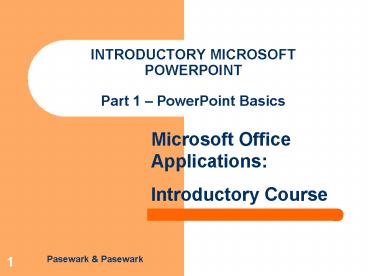INTRODUCTORY MICROSOFT POWERPOINT Part 1 PowerPoint Basics - PowerPoint PPT Presentation
1 / 16
Title:
INTRODUCTORY MICROSOFT POWERPOINT Part 1 PowerPoint Basics
Description:
... Task Pane. 4 ... In Normal view, the three toolbars displayed on the ... choose to print handouts with two, three, four, six, or nine s per ... – PowerPoint PPT presentation
Number of Views:36
Avg rating:3.0/5.0
Title: INTRODUCTORY MICROSOFT POWERPOINT Part 1 PowerPoint Basics
1
INTRODUCTORY MICROSOFT POWERPOINTPart 1
PowerPoint Basics
2
Some features in Part 1 are only available in
Office XP.
3
Objectives
- Start PowerPoint.
- Open an existing presentation.
- Save a presentation.
- Navigate through a presentation.
- Use the menus and toolbars.
- Use the Slide Preview and Outline Panes.
- Use the Task Pane.
4
Objectives (continued)
- Use the Slide Pane.
- Use the Speaker Notes.
- Use Menus and Toolbars.
- Change views.
- Delete a slide.
- Print a presentation.
- Exit PowerPoint.
5
Terms Used in This Part
- Normal view
- Outline tab
- PowerPoint
- Print Handouts option
- Print Notes Pages option
- Print Outline View option
- Print Slide option
- Slide
- Slide Preview Pane
- Slide Show
- Slide Show view
- Slide Sorter view
6
Introduction to PowerPoint
- PowerPoint will help you create a professional
presentation. - Illustrate your ideas using slides, outlines,
speakers notes, and audience handouts. - Presentations can include text, clip art, graphs,
tables, charts, and sound or video clips. - PowerPoint provides features such as design
templates and wizards that help make creating a
presentation easier.
7
Starting PowerPoint
- Start PowerPoint by clicking the Start button,
selecting Programs, and clicking Microsoft
PowerPoint.
8
Opening and Viewing an Existing Presentation
- To open an existing presentation, choose the
presentation from the list in the PowerPoint task
pane under the heading Open a presentation or
choose Open from the File menu. - If the presentation you want to open is not in
the list, click the More presentations folder. - To view the presentation, select View Show from
the Slide Show menu on the menu bar.
9
Saving a Presentation
- To save a new presentation, choose Save As from
the File menu or click the Save button on the
toolbar to display the Save As dialog box.
10
Views
- Normal view displays four panes the Slides pane,
the task pane, the Outline pane, and the notes
pane. - Notes Page view displays your slides on the top
portion of the page, with the speaker notes for
each slide in the notes pane on the bottom of the
page. - Slide Sorter view displays miniature versions of
the slides on screen so that you can move and
arrange slides easily by dragging. - In Slide Show view, you can run your presentation
on the computer as if it were a slide projector
and preview how it will look.
11
Using Menus and Toolbars
- PowerPoint first displays a short menu with only
basic commands. - Expand the menu by clicking the arrows at the
bottom of the menu. - PowerPoint adjusts the menus to display the
commands you use most frequently, adding a
command when you choose it and dropping a command
when it hasnt been used recently. - In Normal view, the three toolbars displayed on
the screen by default are Standard, Formatting,
and Drawing.
12
Deleting Slides
- Display the slide you want to delete, and choose
Delete Slide from the Edit menu. - If you accidentally delete the wrong slide,
immediately choose Undo Delete Slide from the
Edit menu to restore the slide or click the Undo
button on the toolbar.
13
Printing a Presentation
- PowerPoint offers several print options
- Slides option
- Notes Pages option
- Outline View option
- You can also choose to print one, two, three,
four, six, or nine slides per page.
14
Printing a Presentation (cont.)
- In addition
- You can choose to print all the slides, only the
current slide, or any combination of slides in
your presentation. - You can choose either the Grayscale or Pure black
and white option. - To make sure that the slides print on the page
correctly, there is a Scale to fit paper option. - With the Frame slides option, you can choose
whether the border of the slide appears when
printed.
15
Closing a Presentation and Exiting PowerPoint
- To close a presentation, choose Close from the
File menu or click the presentations Close
Window button. - To exit PowerPoint, choose Exit from the File
menu or click the PowerPoint Close box in the
upper-right corner of the screen. - If there are any unsaved changes to a
presentation that you have been working on, you
will be asked whether you want to save them
before exiting.
16
Summary
- PowerPoint can help you create a professional
presentation. When you start PowerPoint, you have
the choice of opening an existing presentation or
creating a new one. - You can view your presentation four different
ways Normal view, Notes Page view, Slide Sorter
view, and Slide Show view. - You can print your presentation as slides using
the Slides option, with notes using the Notes
Pages option, or as an outline using the Outline
View option. You can also choose to print
handouts with two, three, four, six, or nine
slides per page. - To exit PowerPoint, choose Exit from the File
menu.































